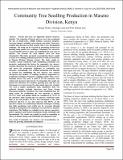| dc.contributor.author | Adongo, Walter Otieno | |
| dc.date.accessioned | 2019-08-13T07:23:34Z | |
| dc.date.available | 2019-08-13T07:23:34Z | |
| dc.date.issued | 2019-07 | |
| dc.identifier.issn | 2454-6194 | |
| dc.identifier.uri | https://repository.maseno.ac.ke/handle/123456789/1299 | |
| dc.description.abstract | Forests and trees are important natural resources
globally. The reduction of forests and tree cover has occasioned
the loss of biodiversity, wildlife habitat, ecosystem integrity;
increased climate variability and reduced crop yields. These have
resulted into decrease in food security thus a key development
challenge. The trend can be reversed by promoting on-farm tree
planting using quality tree seedlings. Community tree nurseries
can provide this; however many are established but soon cease to
operate. The reasons for such failures have not been
documented. This study, premised on production theory sought
to assess tree seedling production processes of such tree nurseries
in Maseno Division, Kisumu County. The study sought to:
Examine reasons considered while establishing community tree
nurseries; understand the factors for community tree nursery
location; determine the reasons for producing given tree species;
and assess the production challenges in community tree
nurseries. Conceptually, tree seedling production cost depends
on reasons for establishing the tree nursery, tree nursery
site;species and number of seedlings produced augmented by
production techniques. Purposive sampling regime with a crosssectional survey was used. A total of 54 tree nurseries were
visited and operators interviewed. To triangulate the results ten
closed tree nurseries; five farmers growing trees and five key
informants were interviewed. Pre-determined interview schedule
was used to gather quantitative data. Qualitative data was
collected through in-depth interviews and Focus Group
Discussions guided by checklists. The study established that: the
main reason for establishing the tree nurseries is income
(53.7%); water and potting media are considered by 72.2% of
the operators while location the tree nursery; Fuelwood ranks
high as an end product (33.9%) and Eucalyptus is the most
preferred (83.3%). It was also observed that 88.9% of the
operators mainly use traditional production techniques resulting
into high production costs which can be overcome through
training in management of community tree nurseries as business
enterprises. The findings are valuable to tree nursery operators,
policy regulators and research institutions locally, nationally and
international. The results can equally be used in responding to
effects of climate change and Sustainable Development Goals. | en_US |
| dc.description.sponsorship | N/a | en_US |
| dc.publisher | IJRIAS) | en_US |
| dc.relation.ispartofseries | Volume IV, Issue VII,;2454-6194 | |
| dc.subject | Community tree nursery, cost of production, onfarm tree growing, sustainable development | en_US |
| dc.title | Community Tree Seedling Production in Maseno Division, Kenya | en_US |
| dc.type | Article | en_US |

